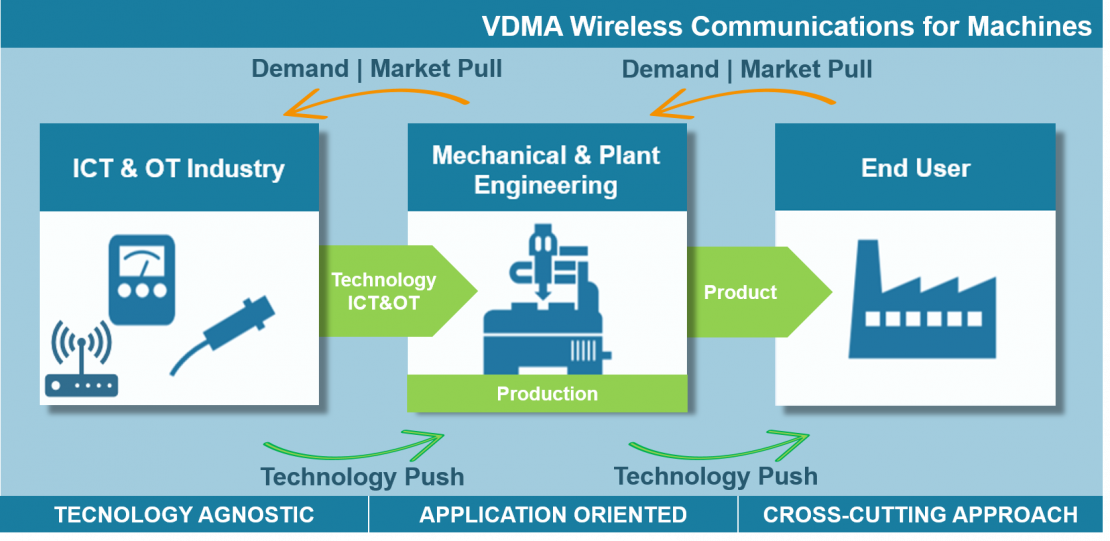5G and other wireless technologies are becoming increasingly important in mechanical and plant engineering. To ensure that mechanical engineers speak with one voice, the VDMA launched the working group Wireless Communications for Machines on March 1. This officially transfers the extensive preparatory work of the VDMA 5G User Group, including LAPP, into a working group with 81 founding members.
Wireless technology has only had a niche position in industry so far. Wireless networks and Bluetooth are used in hand-held scanners or driverless transport systems as well as in some dynamic applications where cables might wear through constant movement. However, wireless systems have not yet been able to achieve widespread success. One reason, for example, is that these wireless technologies do not transmit PLC control signals quickly and reliably enough in real-time critical applications.
5G raises the claim to change this. In future, users should be able to efficiently connect Industrial Ethernet, TSN and 5G. LAPP has been working on the topic of 5G for a long time and is now also working together with users and manufacturers in the new Wireless Communications for Machines working group by the VDMA. LAPP represents a clear position here, emphasises Dr. Susanne Krichel, Senior Manager Business Development IoT: “There is no wireless without cables. 5G is not a threat to the cable, but an addition.” Many applications that require wireless connection technology could be implemented wirelessly with 5G. However, the upcoming 5G releases still have to prove whether 5G really is as real-time capable as promised.

Technology-neutral evaluation
The new working group is intended to organise a transfer of knowledge with all the relevant players along the value chain and to deal with the issues in a technology-neutral and holistic manner from the perspective of various mechanical engineering sectors. This involves close collaboration with the global 5G-ACIA initiative (5G Alliance for Connected Industries and Automation), which was founded in early 2018 by ZVEI. It aims to develop and standardise 5G in a manner that is appropriate for the industry and to design and distribute the regulatory framework. The VDMA’s new working group takes on a more technology-neutral view. It promotes the integration of wireless communication in machine and production systems and identifies the requirements of mobile and stationary machines concerning wireless technologies and communication systems.
Initial focus areas have already been defined at the founding meeting. In addition to the core applications for wireless solutions such as machine-to-machine communication and mobile communication, these also include assessment criteria for the use of wireless solutions and their validation. Important criteria for use in production include simplicity and ease of maintenance. The reason: Automation specialists do not usually have IT specialists, and reliable operation of a wireless network already poses some enormous challenges for them. It needs to be possible for maintenance personnel to remedy errors without long production downtimes, for example during the night shift, and without in-depth IT knowledge. Here, wireless technology has to be just as easy as the equivalent cable networks: Any electrician can replace a defective cable or switch.
LAPP positions itself on wireless solutions
Whether or not the wireless factory is a utopian ideal will become apparent in the coming decades. LAPP is well aware of the effects of 5G on future networking and data communication and is preparing for it. The expansion of infrastructure in individual countries and in factories, also referred to as the backbones, is of interest to LAPP. There, more glass fibres, more copper cables and new antenna masts and access points are needed. In future, 5G infrastructure in cities and communities will need to be wired, and the access points in factory buildings will also depend on cables. The merging of wired and wireless technologies into a complete industrial infrastructure is exciting for LAPP. Everyone in mechanical and plant engineering has to deal with new technological approaches such as software-defined networks and standardised interfaces such as OPC-UA and the topic of middleware: Ralf Moebus, Head of Product Management Industrial Communication “We are convinced that 5G and all the other existing and forthcoming wireless technologies represent an ideal supplement to wired communication solutions, each with their own specific advantages and disadvantages.”
